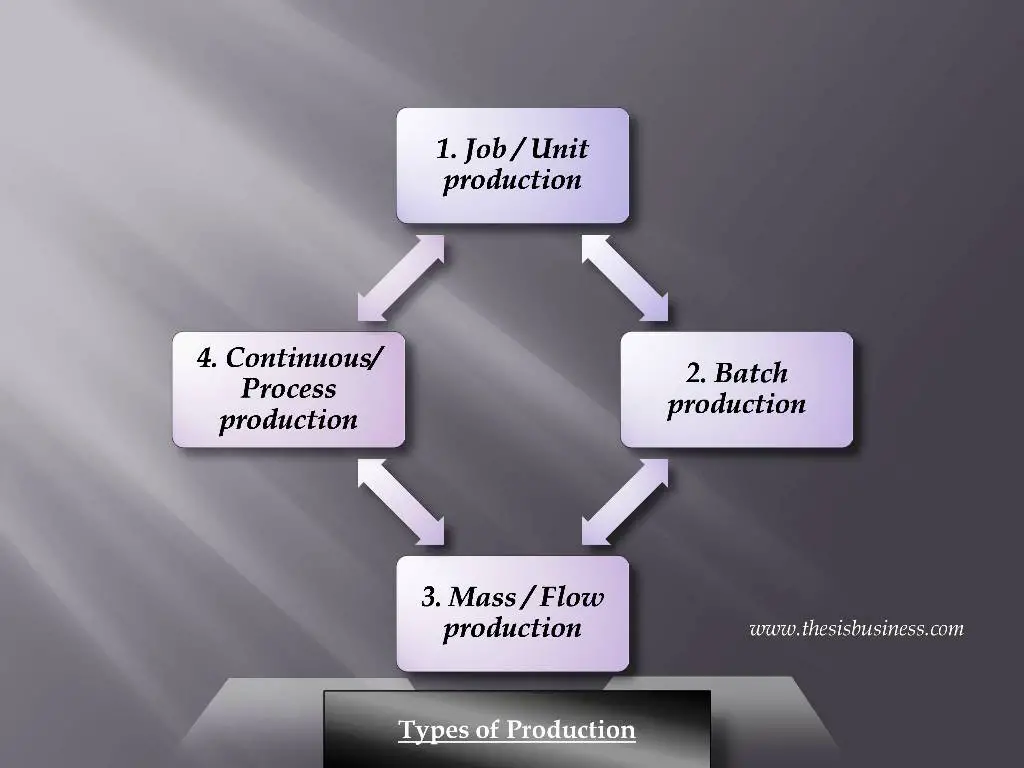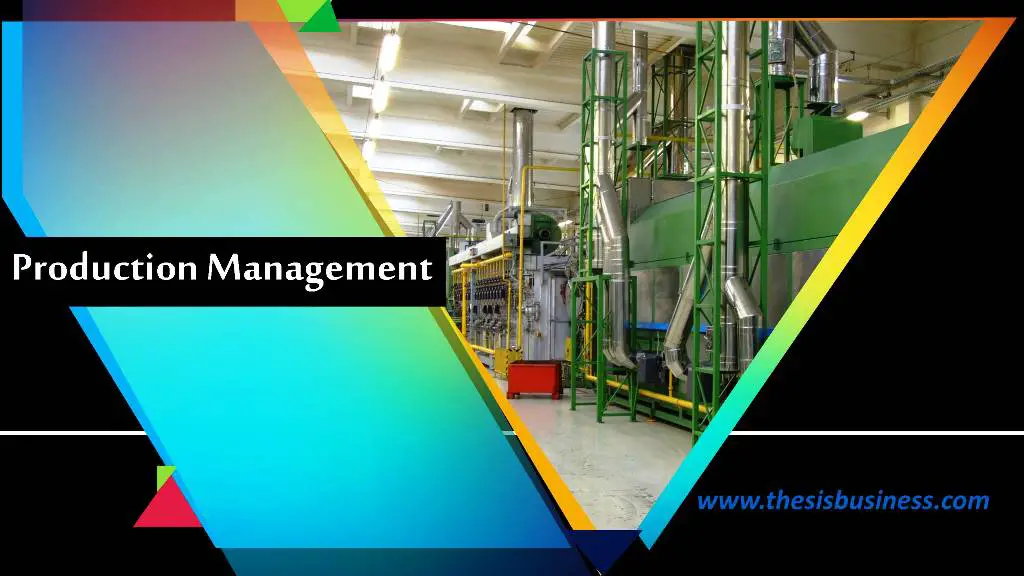In its simplest meaning, production management means controlling, planning, organizing and directing, and executing the production activity. It can also be said as the supervision of the 6 Ms, namely Men, Methods, Material, Management, Money, Machine, Market. Production management is the efficient management of a production process.
Production management also entails decision making, such as how much costs shall be incurred in particular production practice, how much raw materials shall be supplied, what kind of machine usages shall be taken under consideration, the manpower that shall be needed for a smooth and hustle free production, etc. are to be decided by the production manager.
The ultimate goal of production management is to process raw materials, and produce the quality finished product, keeping all the other necessities into consideration. Production management is often referred to as operation management.
Table of Contents
Types of Production –

Which type of production a company shall adhere to depends on the kind of product that is to be manufactured. It also depends on the number of products that are to be produced, the supply of raw materials, the demand for the product, etc.
Based on the factors that decide the production, there are mainly four types of production management.
1. Job / Unit production
2. Batch production
3. Mass / Flow production
4. Continuous/ Process production
1) Job/Unit Production –
In this method, products are manufactured in response to customer orders. Since continuous demand for such products is unlikely, production occurs only when consumers place orders for the items to be manufactured. In general, the goods generated are non-standardized and heterogeneous in nature.
The job production may retail from the smallest of merchandise, such as a dress that is to be tailored for a specific individual to the construction of a bridge or road.
Production planning is relatively simple for small-scale jobs that require no specialized equipment. This enables goods to be produced to the specifications of their customers and can normally be added during the manufacturing process without affecting its development.
It’s a method of production used by high-end brands, including Harley Davidson and Dell. Harley Davidson offers a wide range of accessories that can be personalized to suit the customer’s needs. In the same way, you can build your DELL laptop using the specifications provided on their website.
2) Batch Production –
When products are made in batches rather than individually or continuous processing, batch production is used as the production method. Batch production is done in batches. The producer already knows the number of units he needs, and they are produced in a single batch.
Candles, for example, are being made in batches, which ensures that each phase of the manufacturing process takes place at the same time on the same batch of candles, and so the pre-decided number of candles are made in that batch.
Batch production methods are often used to manufacture parts of a finished product that will go through several stages before being completed. This also allows the manufacturer to create a variety of items with various variations.
3) Mass/Flow Production –
The term “mass production” refers to the process of making several copies of an object in a consistent manner. Flow production refers to the processes used and the quickest and safest methods for protecting employees and completing tasks at the lowest and most reasonable cost.
In this type of production, separate operations make up the production process. When one operation is done, it is immediately passed on to the next until it is finished. There is no lag between the completion of one phase and the start of the next.
Specialization is usually the aim of an assembly line or a mass manufacturing facility. There are several workstations mounted, and the assembly line rotates through them one by one. Work is performed in a specialized fashion, with each workstation handling only one form of task.
4) Continuous/Process Production –
A continuous manufacturing flow aims to create a continuous flow of materials to manufacture, process, or produce. A continuous or nearly continuous physical flow of materials is needed in a continuous production system. It employs specialized machinery to mass-produce standardized products in large quantities.
Different parts flow from one unit to the next in continuous processing to create a finished product. There are no gaps between the various stages of development. It’s a well-organized system that uses sophisticated equipment and produces large quantities.
Even though many of today’s manufacturers use sophisticated machines or robots to produce their products, continuous manufacturing has been around for a long time. For instance, the Fourdrinier machine uses a continuous method to make paper.
Scope of Prodution Management –
Production and operations management is concerned with converting inputs into outputs using physical resources to provide the customized utilities to customers while also achieving the other organizational goals of performance, effectiveness, and adaptability.
Production planning is critical in modern manufacturing and should be used by manufacturing facilities all over the world. Production planning sets out a simple strategy for production, implements it, and tries to improve it each time it is run, thus optimizing production and operational performance.
Some of the below-enlisted points could be counted under the scope of production management –
- Location of Facilities needed
- Plant Layouts
- Designing of products
- Process Designing
- Control of Production and Planning
- Quality Control
- Materials Management
1) Location of Facilities needed –
The decisions as to where a certain production shall be carried out, totally fall under the scope of production management. Keeping in mind the geographical demography of an area and its benefit or harm, a suitable place must be chosen. Looking onto the fact that this a commitment that may last longer and may have a huge impact on the production facility.
2) Plant Layouts –
Right after selecting a perfect location for facilitating the production process comes to the responsibility of setting up a plant. It is the configuration of the workplace, the machinery required, raw materials supply. Everything is needed to ensure a qualitative and desirably quantitative production comes under the plant set-up in a nutshell.
3) Designing of Products –
Designing products is one of the biggest challenges company might experience. Launching products with the best designs shall ensure the sustainability of the company in the market.
4) Process Designing –
Process designing includes the whole procedure and planning for an effective conversation of ideas into reality. While designing a process, the production manager must consider the machinery, the ideas, the layouts, the technology ensuring a smooth and effective work process.
5) Control of production and planning –
Controlling the production and the planning also comes under the purview of production management, it is the wholehearted planning in advance, as to when, how, and where the materials shall come from, following up with dealers, recruitment of employees, etc.
6) Quality Control –
Controlling the desired quality of a product involves preventing defects, optimum care while processing, production to become flawless shall follow the corrective action procedure.
7) Materials Management –
Materials management is a management role that is mainly concerned with the procurement, control, and use of materials and the flow of products and services associated with the manufacturing process to achieve predetermined goals.
References –
- https://books.google.com/books/about/Computer_Aided_Production_Management.html?id=kNCoCAAAQBAJ
- https://books.google.com/books/about/Production_Management_by_Dr_F_C_Sharma_e.html?id=0oQOEAAAQBAJ
- https://books.google.com/books/about/Computer_Aided_Production_Management.html?id=kNCoCAAAQBAJ
- https://www.yourarticlelibrary.com/production-management/production-management-and-its-types/53146
